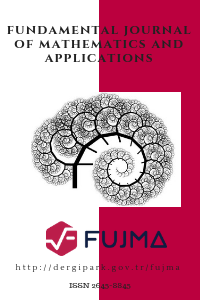Parameter Estimation for a Class of Fractional Stochastic SIRD Models with Random Perturbations
Parameter Estimation for a Class of Fractional Stochastic SIRD Models with Random Perturbations
___
- [1] P. Giles, The mathematical theory of infectious diseases and its applications, J. Oper. Res. Soc., 28(2) (1977), 479-480.
- [2] W. O. Kermack, A. G. Mckendrick. Contributions to the mathematical theory of epidemics–I 1927, Bull. Math. Biol., 53(1-2) (1991), 33-55.
- [3] N. Becker, Estimation for an epidemic model, Biom., 32(4) (1976), 769-777.
- [4] J. Timmer, Parameter estimation in nonlinear stochastic differential equations, Chaos. Soliton. Fract., 11(15) (2000), 2571-2578.
- [5] E. Buckingham-Jeffery, V. Isham, T. House, Gaussian process approximations for fast inference from infectious disease data, Math. Biosci., 301 (2018), 111-120.
- [6] K. Senel, M. Ozdinc, S. Ozturkcan, Single parameter estimation approach for robust estimation of SIR model with limited and noisy data: The case for COVID-19, Disaster. Med. Public., 3(15) (2021), E8-E22.
- [7] M. M. Morato, I. M. L. Pataro, M. V. Americano da Costa, J. E. Normey-Rico, A parametrized nonlinear predictive control strategy for relaxing COVID-19 social distancing measures in Brazil, Isa. T., 124 (2022), 198-214.
- [8] M. Farman, M. U. Saleem, A. Ahmad, M. O. Ahmad, Analysis and numerical solution of SEIR epidemic model of measles with non-integer time fractional derivatives by using Laplace Adomian Decomposition Method, Ain. Shams. Eng. J., 9(4) (2018), 3391-3397.
- [9] K. Rajagopal, N. Hasanzaden, F. Parastesh, et al, A fractional-order model for the novel coronavirus (COVID-19) outbreak, Nonlinear. Dynam., 101(1) (2020), 711-718.
- [10] B. Basti, N. Hammami, I. Berrabah, F. Nouioua, R. Djemiat, N. Benhamidouche, Stability analysis and existence of solutions for a modified SIRD model of COVID-19 with fractional derivatives, Symmetry, 13(8) (2021), 1431.
- [11] H. Mohammadi, S. Rezapour, A. Jajarmi. On the fractional SIRD mathematical model and control for the transmission of COVID-19: The first and the second waves of the disease in Iran and Japan, Isa. T., 124 (2022), 103-114.
- [12] S. Fouladi, M. Kohandel, B. Eastman. A comparison and calibration of integer and fractional-order models of COVID-19 with stratified public response, Math. Biosci. Eng., 19(12) (2022), 12792-12813.
- [13] L. Akinyemi, M Senol, O. S. Iyiola. Exact solutions of the generalized multidimensional mathematical physics models via sub-equation method, Math. Comput. Simulat., 182, (2021), 211-233.
- [14] F. Ashraf, A. R. Seadawy, S. Rizvi, et al. Multi-wave, M-shaped rational and interaction solutions for fractional nonlinear electrical transmission line equation, JGP., 177, (2022), 104503.
- [15] Y. X. Kang, S. H. Mao, Y. H. Zhang, Fractional time-varying grey traffic flow model based on viscoelastic fluid and its application, Transport. Res. B-Meth., 157, (2022), 149-174.
- [16] R. Khalil, M. A. Horani, A. Yousef, et al. A new definition of fractional derivative, J. Comput. Appl. Math., 264(5) (2014), 65-70.
- [17] D. Fanelli, F. Piazza, Analysis and forecast of COVID-19 spreading in China, Italy and France, Chaos. Sol. Frac., 134 (2020), 109761.
- [18] X. M. Wang, Applied multivariate analysis. ShangHai: Shanghai University of Finance and Economics Press, (2014).
- [19] R. Behl, M. Mishra, COVID-19 and India: what next?, Inf. Discov. Deliv., 49(3) (2020), 250-258.
- [20] Y. Wang, Y. Q. Feng, COVID-19 model and numerical solution based on fractional derivative of Conformable, Complex. Syst. Complex. Sci., 19(03) (2022), 27-32.
- ISSN: 2645-8845
- Yayın Aralığı: Yılda 4 Sayı
- Başlangıç: 2018
- Yayıncı: Fuat USTA
Parameter Estimation for a Class of Fractional Stochastic SIRD Models with Random Perturbations
Na NİE, Jun JİANG, Yuqiang FENG
Flux Surfaces According to Killing Magnetic Vectors in Riemannian Space $\mathbb{S}ol3$
Nourelhouda BENMENSOUR, Fouzi HATHOUT
Ricci Soliton Lightlike Submanifolds with Co-Dimension $2$
Erol KILIÇ, Mehmet GÜLBAHAR, Ecem KAVUK, Esra ERKAN
Constant Angle Ruled Surfaces in $\mathbb{E}^{3}_1$
Aykut HAS, Beyhan YILMAZ, Yusuf YAYLI
Berezin Radius Inequalities of Functional Hilbert Space Operators
